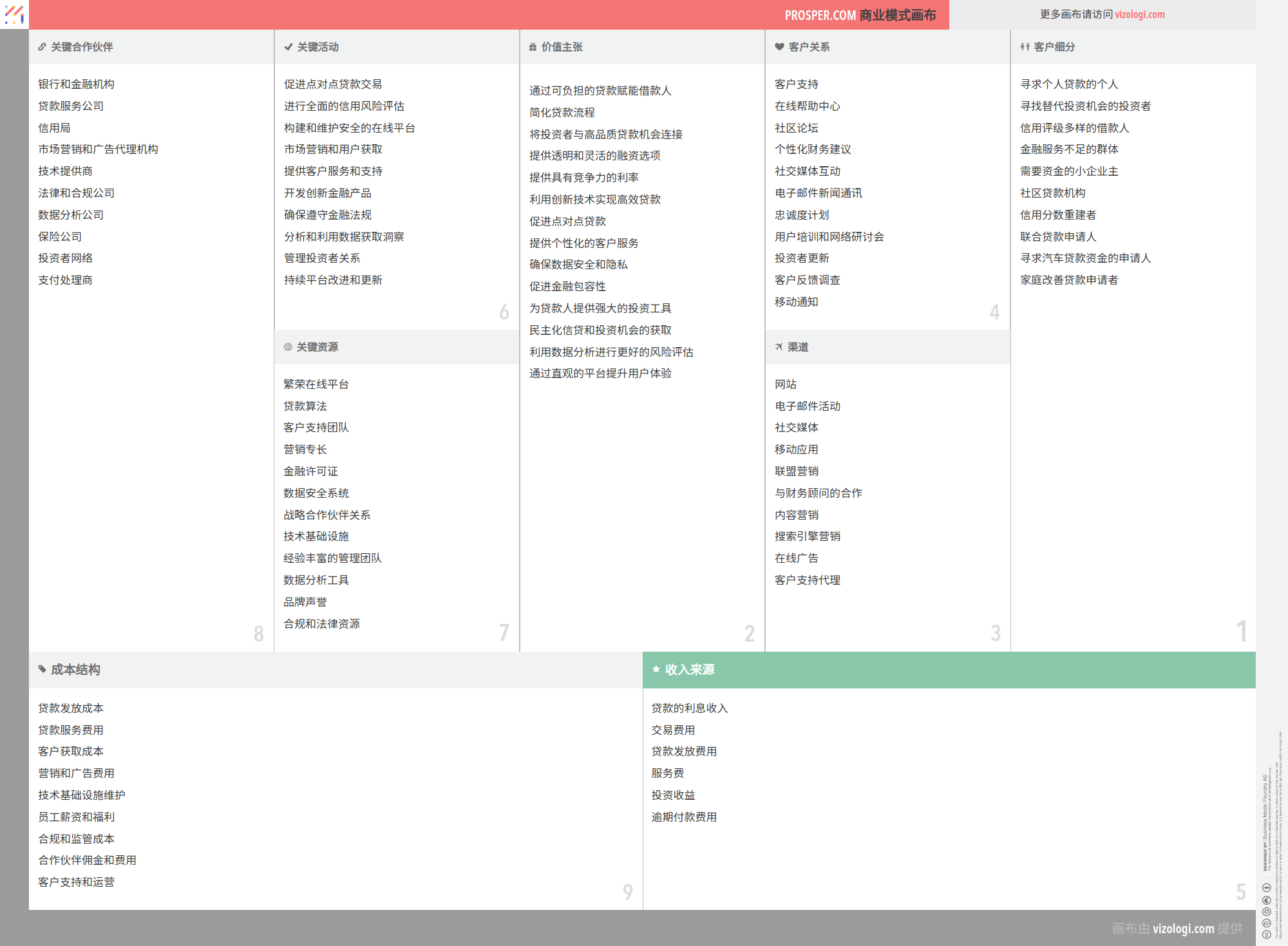Why Prosper.com's Business Model is so successful?
Get all the answers 
Prosper.com’s Company Overview
Prosper 是美国首创的市场借贷平台,自成立以来一直在革新点对点借贷。凭借超过 200 亿美元的贷款资金,Prosper 以安全、透明和高效的方式连接借款人和投资者。公司的使命是通过提供可获得的借贷和投资机会,促进财务福祉,这些机会既具有财务审慎性又具有社会回报性。通过利用尖端技术和强大的审查流程,Prosper 确保用户体验无缝,培养一个金融支持与互利相遇的社区。
Prosper 采用一种独特的商业模式,强调直接的点对点互动,绕过传统银行中介。这种方法使得获得信贷和投资机会的机会实现民主化,使个人借款人能够寻求用于各种目的的无担保个人贷款,从债务整合到房屋改善。而投资者则可以通过借款给信用良好的个人来多样化他们的投资组合,从而获得具有竞争力的回报。Prosper 的平台通过提供信用风险评估工具来促进这些互动,确保双方参与透明且信息充分的借贷过程。
Prosper 的收入模型多面化,旨在维持和扩大其运营,同时为用户提供价值。公司主要通过向借款人收取成功贷款资金后的发起费用来产生收入。此外,Prosper 通过代表投资者管理贷款偿还流程来赚取服务费用,确保及时的收款和分配。这两条收入来源不仅加强了平台的运营稳定性,还将 Prosper 定位为在不断发展中的金融服务领域中的一个值得信赖的长期参与者。
Prosper.com’s Related Competitors
Prosper.com’s Business Model Canvas
- 银行和金融机构
- 贷款服务公司
- 信用局
- 市场营销和广告代理机构
- 技术提供商
- 法律和合规公司
- 数据分析公司
- 保险公司
- 投资者网络
- 支付处理商
- 促进点对点贷款交易
- 进行全面的信用风险评估
- 构建和维护安全的在线平台
- 市场营销和用户获取
- 提供客户服务和支持
- 开发创新金融产品
- 确保遵守金融法规
- 分析和利用数据获取洞察
- 管理投资者关系
- 持续平台改进和更新
- 繁荣在线平台
- 贷款算法
- 客户支持团队
- 营销专长
- 金融许可证
- 数据安全系统
- 战略合作伙伴关系
- 技术基础设施
- 经验丰富的管理团队
- 数据分析工具
- 品牌声誉
- 合规和法律资源
- 通过可负担的贷款赋能借款人
- 简化贷款流程
- 将投资者与高品质贷款机会连接
- 提供透明和灵活的融资选项
- 提供具有竞争力的利率
- 利用创新技术实现高效贷款
- 促进点对点贷款
- 提供个性化的客户服务
- 确保数据安全和隐私
- 促进金融包容性
- 为贷款人提供强大的投资工具
- 民主化信贷和投资机会的获取
- 利用数据分析进行更好的风险评估
- 通过直观的平台提升用户体验
- 客户支持
- 在线帮助中心
- 社区论坛
- 个性化财务建议
- 社交媒体互动
- 电子邮件新闻通讯
- 忠诚度计划
- 用户培训和网络研讨会
- 投资者更新
- 客户反馈调查
- 移动通知
- 寻求个人贷款的个人
- 寻找替代投资机会的投资者
- 信用评级多样的借款人
- 金融服务不足的群体
- 需要资金的小企业主
- 社区贷款机构
- 信用分数重建者
- 联合贷款申请人
- 寻求汽车贷款资金的申请人
- 家庭改善贷款申请者
- 网站
- 电子邮件活动
- 社交媒体
- 移动应用
- 联盟营销
- 与财务顾问的合作
- 内容营销
- 搜索引擎营销
- 在线广告
- 客户支持代理
- 贷款发放成本
- 贷款服务费用
- 客户获取成本
- 营销和广告费用
- 技术基础设施维护
- 员工薪资和福利
- 合规和监管成本
- 合作伙伴佣金和费用
- 客户支持和运营
- 贷款的利息收入
- 交易费用
- 贷款发放费用
- 服务费
- 投资收益
- 逾期付款费用
Vizologi
A generative AI business strategy tool to create business plans in 1 minute
FREE 7 days trial ‐ Get started in seconds
Try it freeProsper.com’s Revenue Model
Prosper.com makes money by combining different business models. Below, you will find the list of the different monetization strategies identified for this company:
- 经纪业务
- P2P借贷
- 启动
- 跨子公司
- 蓝海战略
- 合气道
- 对等网络 (P2P)
- 双边市场
- 共享经济
- 颠覆性趋势
- 把握方向
- 精益创业
- 颠覆性银行业务
- 在线市场
- 社区资助
- 众人交易
- 众筹
- 按需经济
- 去中介化
- 可交易货币
- 交易促进者
- 动态定价
If you enjoyed this content, you’re in for a treat! Dive into our extensive repository of business model examples, where we’ve dissected and analyzed thousands of business strategies from top tech companies and innovative startups. Don’t miss out!


